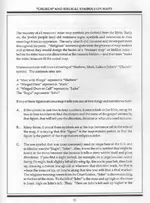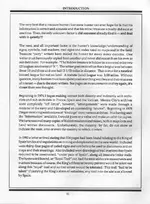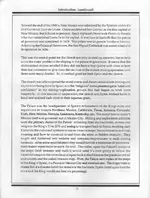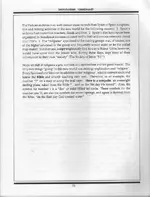gollum
Gold Member
- Joined
- Jan 2, 2006
- Messages
- 6,770
- Reaction score
- 7,734
- Golden Thread
- 0
- Location
- Arizona Vagrant
- Detector(s) used
- Minelab SD2200D (Modded)/ Whites GMT 24k / Fisher FX-3 / Fisher Gold Bug II / Fisher Gemini / Schiebel MIMID / Falcon MD-20
- Primary Interest:
- All Treasure Hunting
- #541
Thread Owner
OH MY GOD!!!!!!
Lamar made a joke! I can hardly believe my eyes! HAHAHA I don't take offense, and not one thing I have done or posted falls under the "pot calling the kettle black" category. All I have done was to take historical documents whose authenticity nobody (but you) questions, and quote them regarding the Jesuits. I have never insulted them as some have. I know their body of work. I also know that there is a lot left out of history that in many cases can be somewhat brought to light in the words of the Jesuit Fathers themselves, and by finds that I know to be authentic.
You say that the Jesuit Fathers would NEVER have gambled. Maybe you should read Father Charles Polzer SJ's Book "Rules and Precepts of the Jesuit Missions of Northwestern New Spain" (Tucson, 1976) He recounts the stories. Also, the DRSW Master Database (microfiches of original letters between Jesuits in the new world):
http://saint-denis.library.arizona.edu:4000/cgi-bin/museumLogon.cgi
Is it slander when I quote the words of the Jesuit Father Juan (Johan) Nentvig when he gives us the reasons for the Churches possessing great riches (In Rudo Ensayo)?
http://southwest.library.arizona.edu/rudo/index.html
Although in these miserable times opposing opinions have arisen among critics, some praising and others condemning the care and expense of adorning and maintaining the temples with all possible dignity and decency for the reverence due to the Supreme Maker of all creation, I will not enter into a dispute over the subject, but I believe in what Our Mother, the Holy Roman Catholic Church, has always praised, approved, practised, and in a certain fashion glorified in the lives of its Saints. One learns from the lessons of St Ignatius of Loyola, father and founder of the Society of Jesus, when he says in praise of that Holy Patriarch, “Templorum nitor, catechismi traditio, concionum ac Sacramentorum frequentia ab ipso incrementum accepere.”I shall say that my heart rejoices with delight, and I feel more inclined to worship and praise Our Lord when I enter any well adorned church. I must let the admiration argument prevail, a maiori ad minorem [from the highest to the lowest], for if we who are more rational than the Indians find incentive and devotion in temples that outshine others by their glowing adornments and will choose those in preference to the slovenly ones for Mass, Sermon, Confession, and Communion, how much more must the Indians be in need of such stimuli when nothing of what they hear takes hold upon them unless it enters through their eyes with some sort of demonstration of the Supreme Creator about whom the preacher is speaking? So, when they see that the house of God is well ordered, clean, and beautifully adorned, they perceive at once the magnificence of its Owner and Ruler. I praise the missionaries of Sonora for imitating their great Father St. Ignatius.
.....or from the same Jesuit Father, when he describes some of the Church Adornments (In Rudo Ensayo):
All the churches have side altars, appropriate ornaments, and chalices of silver and in three instances of gold. There are other sacred vessels such as ciboriums, monstrances, large and small candlesticks and crosses, and nearly all churches have silver statues of the Virgin, organs, bassoons, oboes, and bells, not only at the principal missions but at the dependent ones as well. There are also choruses of Indian singers, and masses are celebrated nearly every Sunday, on days of obligation and on the principal festival days with vespers the evening before when required. And there are processions and other ceremonies of the Holy Church which are accomplished with all possible dignity in order to present a visual display of the majesty of our Holy Religion to the neophytes so that they may remain impressed with its splendor and be attracted to it. Their disposition piae affectionis is to believe through their eyes rather than their ears.
Is it slander, when I quote Father Joseph Och SJ from his book (Missionary in Sonora; the travel reports of Joseph Och, S.J., 1755-1767)?
The cathedral church possesses an exceedingly rich treasure in its gold and silver church appointments. In Spain and the Indies the prebendaries and other canons do not have their choir at the high altar. Rather, not far from the church entrance is a large, high partition in front of their seats, and from the choir to the high altar for their sole use runs an aisle enclosed on both sides by railings. These railings run through the entire cathedral church and are of the finest cast silver, each amounting to at least eight hundred weight. The colossally large, silver hanging lamp inspires awe in all visitors. It is more than eight feet across and is very thick and massively decorated. The chains with finger-thick silver links are so heavy that when a ladder is leaned against them they do not move. A man can quite comfortably walk around the edge of the lamp. The decoration is rather ponderous, yet its manufacture by a goldsmith [sic] is supposed to have cost two thousand pesos. I omit mention of the many thick, large silver candlesticks, monstrances, and ciboria of finest gold. Suchlike are found in proportion and abundance in all churches, even those in the smallest villages for the glorious Divine service.........
......or when I again quote the very same Jesuit Father regarding gold knowledge:
....After this the dishes were ready for use in cookery. .... many were worth more than a ducat because of the thousands of gold scales found mixed in with the clay. This gold could not have been collected through washing without an expenditure of labor in excess of the cost. It was true gold as I proved with a bit of quicksilver with which it immediately formed an amalgam....
to understand why I quote this passage, you need to remember the dates in the title of the book (1755 - 1767). Those are very important dates, since the Precept against mining (or possessing ANY knowledge of mining) was one of those restated in the precepts issued in 1747! There was little doubt that Father Och SJ didn't know about the precept against mining or knowledge of mining. You have to ask yourself why Father Och just happened to be carrying Mercury? The ONLY use for Mercury is to amalgamate precious metals from their rock host. I don't think that Father Och was on his way to manufacture thermometers. By using the Mercury he was carrying to amalgamate the gold scale out of the peasant's dishes, he was displaying his knowledge of mining technology, thereby committing the sin of Disobedience. A very serious thing indeed. Here is the Precept again:
Rule #4. No one will work mines. This includes the prohibition that no one will have any knowledge about the matter of mining, either directly or indirectly. The intention of the precept is to include all forms of knowledge or interpretations that could even fall within the same precept.
You state that:
I imagine that life in the missions became a bit tedious at times and perhaps some Jesuits managed to get their hands on a deck of cards and were playing whist or whatever in the evenings. The Superior General probably caught wind of it and blew it all out of proportion and hence the precept prohibiting card playing. As I recall, gambling was not mentioned in the precept, nor should it have been necessary as all Roman Catholics were prohibited from wagering.
RIDICULOUS! Not only was the precept originally given, it had to be restated and specified due to Jesuit Fathers following the WORD of the Precept and not its' INTENTION! Your apologist roots are showing! Even Father Polzer SJ amditted these facts.
also.............
We cannot however, see any of the determental effects of these same Jesuits. We find no vast hidden treasure caches, nor do we find any incriminating physical evidence. You like to point to the splendor of the colonial churches and yet in doing so you tend to show a narrow minded view of Roman Catholicism in general. If you had put in your homework in areas where it would best suited you, then perhaps you would have discovered that the decoration and splendor of churches and cathedrals refers back to some of the earliest Church teachings, which tells us that as Christians, we should show humility and modesty in all things except in the Church, which must be decorated and adorned to the very best of our abilities, as it is the house of God and therefore we must show it the proper respect and adoration which it requires.
1st quote in red: You mean evidence like the published works of the Jesuit Fathers themselves? Please read above quotes.
2nd quote in red: I do my homework very well. I would not post something that is a flight of imagination. I also don't postulate ridiculous theories. The Jesuit Fathers themselves put down on paper the many splendors they saw in all the churches in the Northern New World. Those splendid adornments all but disappeared by 1767, when Spanish Soldiers took the Jesuit Fathers by complete surprise (yeah right). You have previously stated that those adornments may have been stolen by civilians. REALLY? I have a little problem with that. Namely; when the Spanish Soldiers arrested the Jesuits, the splendors were already gone. Do you mean to say that civilians stole all the church adornments from under the nose of the Jesuit Fathers who had no idea they were about to be arrested? Sorry Charlie.
Yes, we agree on everything. Everything except what we post here. HAHAHA You still haven't answered my question (third time).
Best-Mike







 My Bad!
My Bad! I would recommend "Wandering Peoples" by Cynthia Radding to get a better feel for the wealth and finances of the missions. As a side note, I don't believe Ms. Radding was a fan of the Jesuits.
I would recommend "Wandering Peoples" by Cynthia Radding to get a better feel for the wealth and finances of the missions. As a side note, I don't believe Ms. Radding was a fan of the Jesuits. The reasons have been lost to history, if they ever existed in the first place and all that remains are the Rules themselves.
The reasons have been lost to history, if they ever existed in the first place and all that remains are the Rules themselves. 
